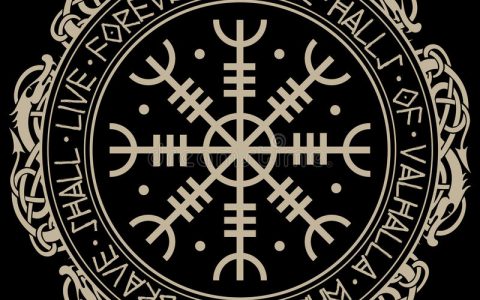The Sistrum (rattle) was a musical instrument that played a major part among Ancient Egypt’s various symbols. Containing a handle and a U-shaped metal frame, it is 30-76 cm wide. The most common metals for making a sistrum are either brass or bronze. Small rings or loops of thin metal on the flexible crossbars make a sound. Moreover, that ranges from a faint clank to a loud jangling when shaken. Sekhem and Sesheshet were the ancient Egyptian names for it. Even though it began as a musical tool, its symbolism and mystical impact evolved beyond that.

The Sistra sprung in Egypt and found their use in a wide range of ancient Egyptian rites and functions. If you would like to know more about the sistra, then worry not. This article is going to throw light on them, besides their meaning, history, and essence.
Sistrum Instrument
The Sistrum (plural: Sistra) was an ancient Egyptian musical percussion instrument having a rattle-like shape. The tambourine is its closest modern equivalent though. Natives believed the goddesses Isis and Hathor had links with the Sistrum when it first emerged in the Old Kingdom.
Moreover, the instrument included a long handle, a crossbar-style frame, and little discs that rattled when shook. To make it, wood, stone, or metal would be the popular choices. The word Sistrum, however, refers to something that is being shaken.
Sistrum Meaning
People in ancient Egypt treated the Sistra as a sacred musical tool having strong magical powers. They would use it to worship Hathor, the Goddess of joy, festivity, fertility, eroticism, and dance in Egyptian mythology. In addition, they also shook it to prevent the Nile from flooding. Besides, people believed that shaking the Sistrum frightened Set (the God of storms, disorder, and violence) away. People would worship Isis typically as a mother and creator. She held a pail signifying the Nile’s deluge in one hand and a sistrum in the other. At times, you can even see Bast carrying the Sistra. Likewise, this also represents her function as a goddess of dance, joy, and festivity.
Read Also: Vegvisir: A ancient Norse symbol
The Sistra could mimic the sound of a breeze hitting and blowing through papyrus reeds. Nonetheless, its symbolic worth vastly surpassed its utility as a musical tool.
Sistrum History
The Sistrum evolved in Egypt and could initially be seen in the Old Kingdom. It had close ties with ritual activities in honor of Isis. Indeed, the goddess and her priestesses are typically depicted carrying a sistrum in Egyptian art. Moreover, it came in two shapes: an oval hoop and a temple shape. The sistra, shaped like an inflated hoop, was used in parades, tributes, festivals, and burial contexts in Greek culture. The earliest specimens come from Minoan Crete (c. 2000-1900 BCE), however. Clay was a popular choice for building them then. Besides, they have two fixed wooden horizontal rods and three clay mobile discs. In addition, these strike the sides of the hoop-shaped frame to produce sound.
However, it might happen that the clay models weren’t meant to be played (sound production is minimal). On the contrary, they rather served as symbols of the tool in funeral situations. Analysts have even unearthed many sistra and other musical instruments in tombs. Thus, this proved that music was an essential element of the afterlife, back in the day. Besides, sistra made of clay could suffice as children’s toys as well.
Sistrum Structure
The sistrum’s arc has a vulture topping, with wide wings and extended feathers. You can find images of the Goddess Meret on both sides of the arc. Moreover, they are just above where the arc fits into the handle. The Chantress of Sobek of Kheny, Tapenu, is present on the sistra handles. In Upper Egypt, Kheny is the ancient village of Gebel Silsila, the huge sandstone quarry site. In this region, however, people worship many versions of Sobek, the Crocodile God. Likewise, as per the name, the Sistra dated from the late Ramesside Period onward.
Sistrum Types
The first Sistrum, also known as Naos-sistrum, appeared in the Old Kingdom and additionally had a close link to Hathor. Moreover, there were carvings of cow horns and the face of Hathor etched on the handles of these Sistra. In rare cases, however, the instrument had a topping of falcons. These Sistra were ornate pieces with many images and features. Sadly, though, only a few authentic antique Sistra exist. Therefore, this species of the Sistra has only lived in artworks and depictions.
Nevertheless, the majority of the Sistra that have survived are from the Greco-Roman period. Further, there were fewer details and a different form on some things. They merely had a loop-shaped frame besides a lengthy papyrus stem-shaped grip, however.
Minoan Sistrum
The ancient Minoans used the Sistra too. Moreover, researchers have discovered several examples made of local clay on the island of Crete. Furthermore, the Archaeological Museum of Agios Nikolaos has five of these on display. On the Harvester Vase, an antique unearthed at Hagia Triada, a sistrum is also on portrayal.
However, analysts are unsure if the clay sistra were real tools that played music or just replicas with symbolic value. Nevertheless, trials with a ceramic replica reveal that such a pattern in clay produces a pleasing clinking sound. Therefore, its use in rituals is likely more favorable.
Modern Sistrum
Throughout the ages, the Sistra has been a ritual instrument in the Ethiopian Orthodox Church. Furthermore, natives still play it during the debtera (cantors) dance at key church festivals. Moreover, you can also find it in Neopagan worship and rites.
The rare revival of the Sistra occurred in 19th-century Western orchestral music. Most notably, it was in the Act 1 of the French composer Hector Berlioz’s opera Les Troyens (1856-1858). However, the tambourine, a near-modern analog, has now taken its place. When shook in short, sharp, rhythmic pulses, the sistra in music has the effect of inciting motion and activity. Like the tambourine, it has a link to religious or joyful events. Those are as follows.
- A sacred rattle in ancient Egypt’s worship of Hathor.
- In modern-day Evangelicalism’s vocal rattling of the tambourine.
- In Romani song and dance.
- On stage at a rock concert.
- To amplify a large-scale orchestral tutti.

In 1988, classical composer Hans Werner Henze (1926-2012) made a piece Sonate für sechs Spieler (Sonata for six players). There, he calls for the flautist to play two sistra.
Sistrum Role
The goddess Hathor’s ties with the Sistra also linked it to the deity’s powers. Since these were Hathor’s character traits, the Sistrum eventually became an emblem of joy, fetes, and erotism. Besides, the Egyptians thought that the Sistrum had mystical powers indeed. As per some versions, the Papyrus plant is a source of the Sistra, which is another Hathor emblem. Furthermore, the Hathor temple in Dendera still houses one of the most iconic images of the Sistrum.
The Sistrum was once a musical tool and symbol that only Egypt’s Gods, high priests, and priestesses could carry. These strong people would use it to frighten Set, the deity of the desert, chaos, storms, and calamity. Furthermore, the Egyptians thought that the Sistrum could also prevent the Nile from flooding. Thus, people began to associate this tool with the Goddess Isis due to these two basic reasons. In some of her portrayals, you can also see Isis with a symbol of the flood in one hand. On the contrary, she holds the Sistrum in her other hand.
Sistrum Symbolism
Even though the Sistra began their life as mere musical instruments, their symbolic worth clearly exceeded their musical functions. As we have shared earlier in the article, the Sistra found their uses in a wide range of ritual practices. Moreover, they were also one of the burial and tomb equipment items. The musical tool had absolutely no function in these cases, however, and served as a mere symbol. In addition, it was also a symbol of eroticism, fertility, and joy.
Further, the Sistra became related to the Papyrus plant. Now, this was an important symbol of Hathor and Lower Egypt over time. As per certain beliefs, Hathor sprung from a papyrus plant. Some sources claim that Isis hid her son Horus in the papyrus thicket surrounding the Nile.

The Sistrum subsequently became a symbol of the Gods Amun and Bastet on account of its papyrus roots. Therefore, it also became a symbol that Egyptians used to pacify Hathor’s wrath. People believed the Sistra could pacify Hathor and any other deity thought to be angry during the New Kingdom era.
Sistrum Roman-Greco Period
Nevertheless, the cultures and beliefs of these two regions mingled when the Romans invaded Egypt. Meanwhile, however, Isis became one of the most popular Gods, and her symbols survived. The worship and value of the Sistrum grew in tandem with the rise of the Roman Empire. During this time, the Sistrum reigned supreme until the arrival of Christianity.
We have already talked about the widespread use of the Sistrum. Therefore, it is regarded as a key aspect of worship and religion in various African regions even today. The Sistrum is still a striking feature in Coptic and Ethiopian churches.
During the Greco-Roman period, the sistrum’s use spread beyond Egypt’s borders. Subsequently, the religion of Isis followed the Romans anywhere they went. The fame of Isis kept soaring. Additionally, every major city had an Isis temple; with Rome’s being the largest and most elegantly designed, near the Pantheon. Beautiful wall murals still adorn the temple and its nearby porticoes, depicting priests or attendants of Isis holding the Sistrum. Furthermore, the Coptic church continues to use the Sistra. Moreover, it aims at the four cardinal points to reflect the scope of God’s creation.
Sistrum Late Period
The royal uraeus (cobra) was at times present in the décor, hinting at the story of the solar Eye. Hathor is the rebellious daughter of Re in this story; music and dance soothe her. The Sistra pacified and satisfied any deity, whether female or male, from the New Kingdom onwards. The effect of this instrument was seemingly verified. A noas-shaped sistrum was a cult object in the Temple of Amun-Re at Karnak. Perhaps, this was possibly due to its ties to Hathor – the female procreative factor needed to sustain Amun-Re’s vitality.
Priestesses held the Sistra honoring the deity face to face in Late Period imagery though. It was a woman’s prerogative to be intimate. Other gods equally gained benefits from the Sistra’s presence as well.
Sistrum Amarna Period
The sistrum showed the Gods’ presence in a very clear way. Hence, it is no shock that it almost had no décor during the Amarna Period, except the papyrus handle. Nonetheless, the queen or princesses held it during the cult of Aten, the sun disc. The Sistra belong among the Gods of the cosmos. As per Plutarch, the Sistra’s arches marked the lunar cycle and the bars reflected the elements. On the contrary, the twin Hathor heads were life and death. The cat, usually placed in the design, was symbolic of the moon.
You can find the names of the royal people on several of these musical tools. The royal family members usually held the Sistra in their hands. Furthermore, the princesses greeted Sinuhe with music and song, as per the Sinuhe story. The sistra, neither finer wind nor string tools, was the musical instrument of choice. The Goddesses dress up as gypsy musicians to enter the birth chamber of Re’s mother in the Westcar papyrus. In addition, Re’s children have the sistra as an escort to them.
Sistrum FAQs
Thus, it is now time to answer all the questions that might have been piling up inside your head. Scroll over to check all the needful answers to the most common FAQs on the sistrum.

What is a sistrum?
A sistrum is an ancient Egyptian percussion tool shook during rites and while facing a deity. It supposedly imitates the sound of papyrus stalks being shaken. Besides, it reflects an old rite related to the myth of Horus’s hidden birth in a papyrus marsh. You will find the Bat symbol connected with Hathor, patroness of music, carved into the handles of the sistra.
What is the Sistrum made of?
The Sistrum consists of a wood, metal, or clay frame set loosely with crossbars (typically draped with jingles). The frame has a handle attached to it.
What does the Sistrum sound like?
There are metal disks or squares, strung onto a set of transverse bars, set horizontally into frames of varying design. Hence, their motion or the free movement of the bars themselves against the frame emits metallic sound from the sistrum. And this only takes place when one shakes it like a rattle. As we have already mentioned, sistra sounded like papyrus stems being shaken. The auditory effects, on the other hand, were often rather limited.
What purpose does a sistrum serve?
The U-shaped rattle found its use in ancient Egyptian, Greek, and Roman traditions. Moreover, there is still use of the sistra in Ethiopian religious music, besides very rarely in orchestral music. Using it gives a lovely eastern flavor.
In open-air processions, the sistrum could beat a rhythm. The tool’s tone appears as both protective and symbolic of cosmic blessing and rebirth. The shape and design of the sistra, besides the symbolic aspect of their sounds, connect it to the divine.
Is a sistrum an Idiophone?
Well, yes. An idiophone is a type of musical instrument that makes sound by using the material it is built of. It does not use strings or a stretched skin, nonetheless. The ancient Egyptians used the sistra in various rituals to ward off evil spirits.



